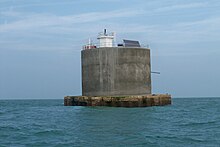Nab Tower
 |
|
|
Hampshire
|
|
| Location | Nab Rocks, Near Isle of Wight, England |
|---|---|
| Coordinates | 50°40′03″N 0°57′04″W / 50.66749733°N 0.951162862°WCoordinates: 50°40′03″N 0°57′04″W / 50.66749733°N 0.951162862°W |
| Year first constructed | 1819 (established lightship) |
| Year first lit | 1918 |
| Automated | 1983 |
| Foundation | steel and concrete |
| Construction | steel and concrete tower |
| Tower shape | massive cylindrical tower with a hexagonal prism light and helipad on the top |
| Markings / pattern | unpainted tower, white light |
| Height | 17 m (56 ft) |
| Focal height | 17 m (56 ft) |
| Current lens | Vega VRB-25 medium intensity rotating beacon |
| Intensity | 2,850 candela |
| Range | 12 nmi (22 km) |
| Characteristic | Fl W 10s. |
| Fog signal | 2 blasts every 30s. (range 2 nmi (3.7 km)) |
| Admiralty number | A0780 |
| NGA number | 1048 |
| ARLHS number | ENG 082 |
| Managing agent | Trinity House |
The Nab Tower was a tower planned for anti-submarine protection in The Solent in World War I. It was sunk over the Nab rocks east of the Isle of Wight to replace a lightship after the war, and is a well-known landmark for sailors as it marks the deep-water eastern entry into the Solent.
During the First World War the British Admiralty designed eight towers codenamed M-N that were to be built and positioned in the Straits of Dover to protect allied merchant shipping from German U-boats. Designed by civilian Guy Maunsell, the towers were to be linked together with steel nets and armed with two 4-inch guns with the idea of closing the English Channel to enemy ships.
However, by the end of the war in 1918 only one had been completed, at a fantastic cost (at the time) of one million pounds, and was located at Shoreham Harbour, awaiting deployment. While another part-built tower would eventually be dismantled in 1924, there remained the completed 92-foot-tall (28 m) metal cylinder sitting on a raft of concrete.
In 1920 the completed tower was towed by two paddle-wheel tugs to the Nab rock, a rock in the deep-water approach to the eastern Solent and previously marked by a lightship. Buoyancy was provided by the honeycomb construction of the concrete base, creating 18 watertight compartments. When these were flooded, the structure sank and settled to rest at an angle of 3 degrees from vertical towards the northeast - a characteristic tilt which is obvious to this day.
The tower was featured as the main setting of the 1951 Hammer thriller, The Dark Light.
...
Wikipedia

